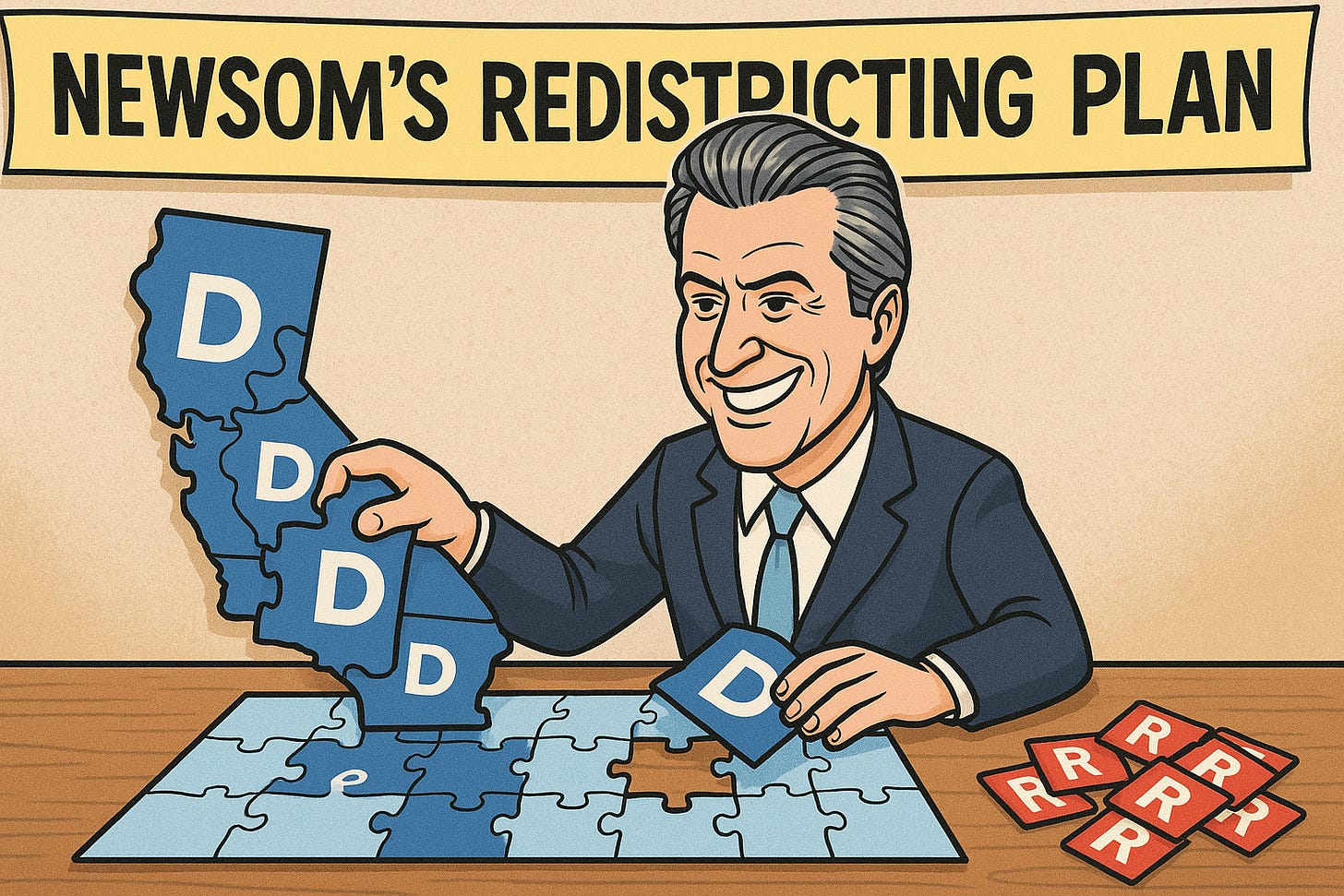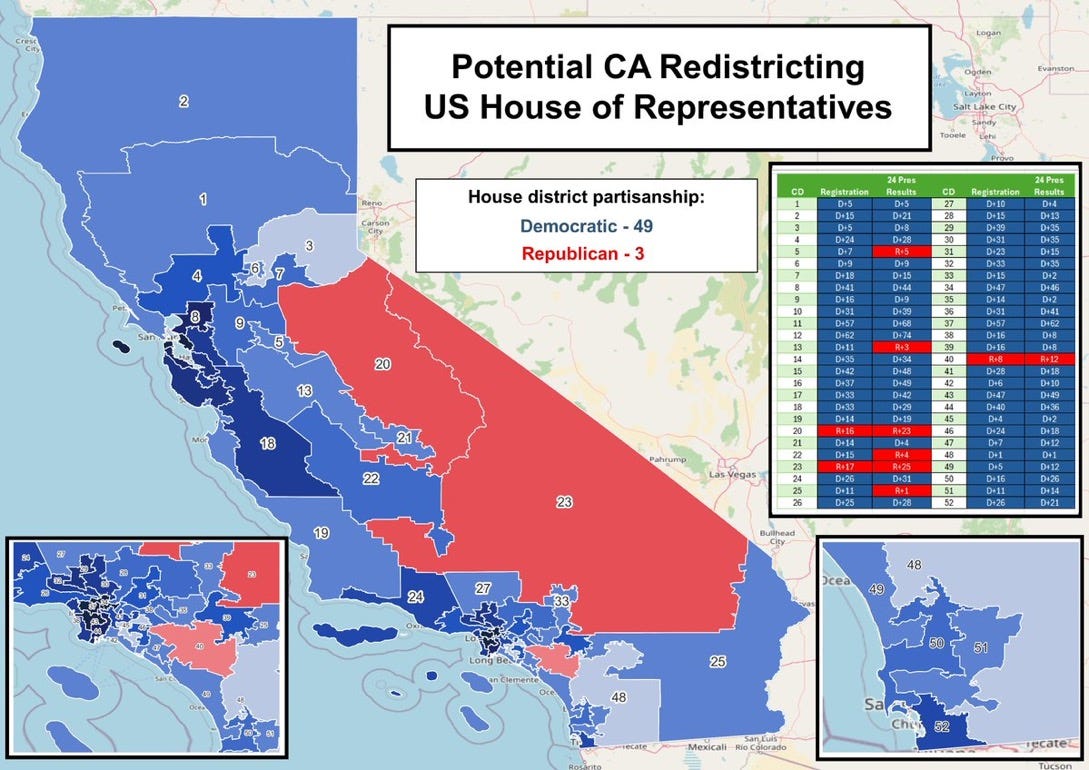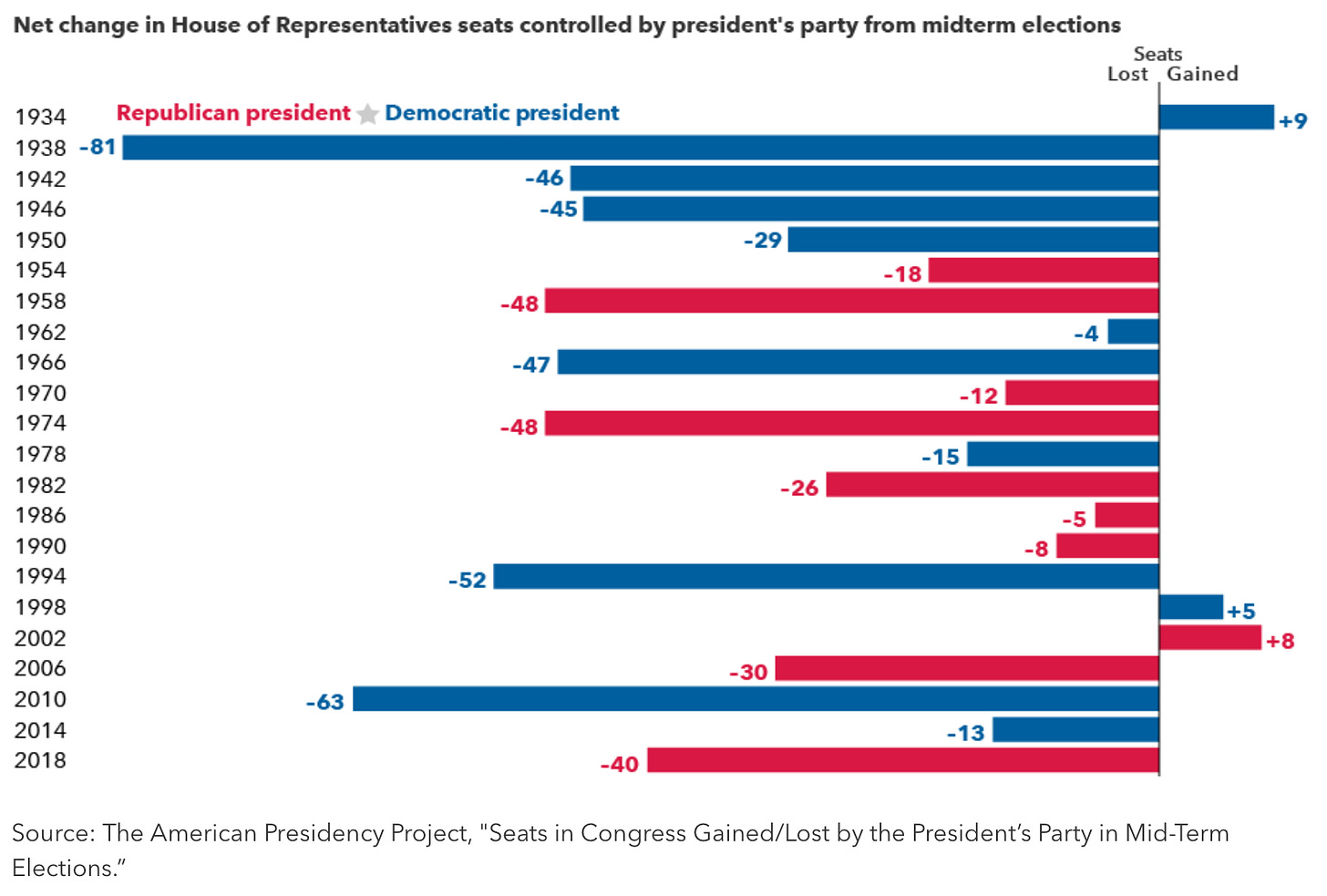Republicans Should Be Very Worried About Newsom’s California Redistricting Gambit Ahead of 2026
With a mere $200 million investment of California taxpayer funds to hold a statewide special election, Democrats could get a significant boost in their efforts to take the House next year…
🕒 7 min read
“Cry Havoc! And let slip the dogs of war…”
This Shakespeare quote from the play Julius Caesar aptly describes the political battlefield Newsom is preparing to unleash on California’s congressional districts.
If Republicans are not worried about what Newsom proposes to do here, they should be. At a news conference yesterday about something else, California Governor Gavin Newsom declared his intention to ask the legislature to put before California voters a ballot measure that, if passed, would take what are already Congressional District maps for California that heavily favor Democrats with 43 seats, and Republicans with only nine, to an absurd level of 49 seats for Democrats and only three for Republicans — according to draft proposals reportedly circulating among Sacramento insiders. Something that could only be done with a radical gerrymandering scheme, guided by sophisticated line-drawing experts with good software. Interestingly enough, however, it appears that Newsom plans to sell the extreme partisan nature of the proposed redraw as a feature — THE feature, in what would be a partisan ballot campaign, framing the measure as anti-Trump.
What Will This Ballot Measure Look Like?
The details on Newsom’s scheme will be clear soon enough. Still, based on what we know, it appears that the plan would be for the legislature to meet sooner than later (unclear whether he would call the legislature back early from their Summer recess), and then ask them to put onto the ballot (at the modest cost of $200 million) what I presume will be a Constitutional Amendment that would do some legal jiu jitsu that would result in putting a very partisan gerrymandered map in front of voters, and asking them to approve these new Congressional lines through the end of this decade, with the Redistricting Commission drawing new lines again after the 2030 census. Of course, a lot of polling research will have been conducted so that the legislature can phrase every aspect of what is in front of the voters in the most favorable light - most notably the ballot title and summary. Speed will be of the essence to get this in front of voters, presumably in early November (they may have to change some existing laws to do this — but with a two-thirds supermajority and the ability to make changes in law effective immediately, this is not a difficult impediment).
They would need to get the election certified and then get everything in place to administer the elections on the new lines. But as you may recall, back in 2021, the Redistricting Commission finished its work and delivered the new maps to the Secretary of State in late December 2021, and it all worked out.
The Campaign To Pass The Measure
The campaign plan to pass this measure seems to write itself. If you can make this vote a referendum on President Trump (if you are unhappy with him, vote yes; if you think he’s excellent, vote no), that should result in a resounding win. You would lean straight into the partisan nature of the maps, pointing them out as a necessary response to Trump. There were two statewide public opinion polls taken last month, one by the Public Policy Institute of California and the other by the University of California, Irvine, and both had the President’s approval numbers down in the mid-30s. Not a surprise in an intensely blue state. And validating the wisdom of a partisan strategy to pass the redrawn maps.
The Politics Of New Lines
There are two hurdles that Newsom will have to leap over in working with the State Senate and State Assembly Democratic Caucuses. The first is getting enough of each caucus on board to reach the two-thirds threshold in each chamber. The supermajorities are so large that they can afford to lose a few votes in either. I don’t think this will be a problem in this hyper-polarized environment, where everything will be framed as, “So are you committed to stopping what Trump is doing to our country, or not?”
The other hurdle is the political stress that comes with changing these lines. Changing these lines doesn’t just negatively impact the nine Republican Members. Still, to achieve their objective of eliminating six GOP seats, they have to move a lot of Republicans into Democratic seats. That sounds easy, except maybe there are current Democrats in Congress who do not want more GOP voters in their seats. In addition, there will be a lot of jockeying by legislators who want to be well-positioned to run for the six brand-new Democratic seats. All of this will be overcome, but this will be the wrangling behind closed doors.
Unless You’re Darrell Issa, This Could Spell Big Trouble for GOP House Members
I wrote on Wednesday about how the map I have seen floated around creates a 49-3 Democrat House District advantage. I said, “I spoke with a California redistricting expert yesterday. For those curious, with this map, Rep. Darrell Issa would be the only Republican sitting pretty, with a re-election to a very red district secure. For the other two Republican seats that would be very safe, two GOP incumbent members would have to duke it out. Vince Fong and Jay Obernolte are in one, and Tom McClintock and Kevin Kiley are in another. Brutal. Oh yes, you would say bye-bye to not only the loser of each of those two showdowns, but also Doug LaMalfa, David Valadeo, Young Kim, and Ken Calvert.”
Why Republicans Should Be Very Worried
First and foremost, the stakes here are pretty high. If you follow long-term trends, mid-term elections when a President’s popularity is not super-high tend to go poorly for the President’s political party. This is a guideline, not a rule. However, Republicans have a tiny margin for their House majority (in 2024, 220 Republicans won seats, and 215 Democrats). So a play to swing six seats from Democrat to Republican is huge. This maneuver is ostensibly aimed at countering a similar play in Texas, where the Republican Governor and GOP supermajorities in the State Senate and State House are looking to draw lines that would shift as many as five seats from Republican to Democratic. Still, all of these are moves of political earthquake proportions.
But the real reason Republicans should fret if this moves forward out of the legislature and to the voters is this — Gavin Newsom is focused on one outcome above all others. With the same intensity that Sauron was fixated on the One Ring. Newsom wants to be President of the United States. There is no way that he makes the final decision to run this play because he thinks there is even a small risk of him losing, and it blows up in his face. Imagine a group of Democratic pollsters lined up like judges at an Olympic diving competition. Newsom will look to all of them for a thumbs-up or a thumbs-down. He doesn’t move forward if they don’t all score, making the chance of winning highly likely.
Can Republicans Stop This From Happening?
There are two ways that Republicans, with their agency, can realistically try to stop this.
The first is what I would call brute force. By that I mean a truly nationally funded, expensive, comprehensive opposition campaign. PACs, SuperPACs, and other major national funding sources would need to be brought to bear. And to be fair, it’s been a long time since we have seen the effect of significant and impactful statewide spending on the GOP side of things in California. It’s been so long that it is more the stuff of legend. Would that happen? Well, that’s when Republican heavyweights will be looking to their panel of pollsters, asking that very question.
The second would be through an extremely aggressive legal effort. And frankly, the path would need to be through federal courts. No one should forget that we have a pretty activist and liberal State Supreme Court majority (six of the seven justices were appointed by Gavin Newsom or Jerry Brown). I don’t think it would take long for them to suck any legal challenges on this in a local Superior Court right into their courtroom for swift, predictable action. No, it would have to be a federal challenge to find something problematic that can either stop the ballot measure from happening or stop post-passage implementation — or perhaps gum up the works enough that it creates a delay in the process, just enough to prevent things from impacting the 2026 elections. Outside of the control of Republicans, there could be a fumble with the internal politics of the Democrats, or maybe those pollsters don’t give Newsom the assurances he wants.
Just The Latest Battle In The Epic War
A mid-decade redistricting battle is emerging across the country, emblematic of the great cultural and political divide in America today. We will all be watching to see how this California piece plays out.
Jon Fleischman is a longtime political strategist and analyst who has been deeply involved in California politics for well over three decades. He is a former Executive Director of the California Republican Party.






Amazing that this is even a consideration, considering CA budget woes as they exist today. If Newsom continues along this path, he will be setting himself up, once again relying on taxpayer dollars to do his dirty work. I guess he gets good national headlines for going up against Texas, but here in CA, we already have an independent redistricting commission.
Those that fight monsters —-must be careful not to become monsters themselves.